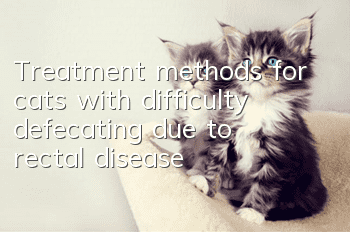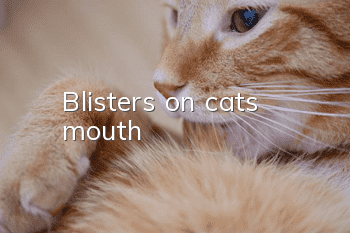Treatment methods for cats with difficulty defecating due to rectal disease

The rectum is an indispensable part of the cat’s digestive system. The rectum has the functions of defecation, absorption and secretion. It can absorb a small amount of water, salt, glucose and some drugs, and can also secrete mucus to facilitate defecation. Under normal circumstances, there is no feces in the rectum and the anal canal is closed. When the rectum is stimulated by internal or external stimulation of the body or infected, diseases may also occur that cause difficulty in defecation.
1. Rectal diverticulum
Rectal diverticula are sac-like protrusions formed by local bulging of the rectal wall. Rectal diverticula affect cats' defecation, causing feces to accumulate in the rectum and causing digestive dysfunction. Larger rectal diverticula can cause damage or even perforation of the rectal muscle layer, causing inflammation of the rectal mucosa. The cat frequently looked back and looked at its belly, but only saw hard work, no defecation or only a small amount of feces. There was no abnormality in body temperature and pulse. There was swelling on one or both sides of the cat's anus when inspected. The swelling was solid when palpated, and some had a fluctuating feeling. Rectal examination revealed a pouch on one side or both sides of the rectum, with a large amount of feces accumulated.
Conservative therapy can be used in the treatment of mild rectal diverticulum. If defecation is not completely blocked, alcohol stimulation therapy can be used. Remove the rectal feces, lay the cat prone, and disinfect the skin on both sides of the anus. Put a gloved finger into the rectum for guidance. Use a disposable syringe to absorb 4 to 5 mL of 95% alcohol, and insert a needle parallel to the rectum in the skin on the side of the rectal diverticulum. If the depth is slightly beyond the rectal diverticulum, inject and pull it out until it is subcutaneous; if there is also a rectal diverticulum on the opposite side, inject the same amount of alcohol in the same way. This method mainly uses the stimulating effect of alcohol to proliferate the connective tissue on both sides of the rectum and fix it, preventing the rectum from excessively expanding to one side when feces accumulates. Generally, when the aseptic inflammation and swelling subside, the rectal diverticulum can gradually return to normal.
Surgical therapy can also be used, such as plication surgery. The advantages of this method are simple operation, little damage to the rectum, fast postoperative recovery, and easy care. However, if the diverticulum is too large and excessive sutures are used, it is easy to relapse. The second method is to perform a longitudinal oval resection on the rectal diverticulum, which means to partially remove the sac-like protrusion of the diverticulum and suture the atretic intestine to restore the intestinal cavity to its normal diameter. The advantage of this method is that the operation is thorough, it is not easy to relapse, and it is suitable for larger diverticula.
2. Rectal prolapse
Rectal prolapse refers to the protrusion of the rectal mucosa from the anus. Also known as rectal exstrophy, anal exstrophy, and anal prolapse. Cats are prone to rectal prolapse when they have parasites, enteritis, tumors, or perineal hernia. However, many causes of tenesmus can also easily cause rectal prolapse, and there are also many cases of rectal prolapse caused by constipation in cats.
The treatment and prognosis of rectal prolapse in cats depend on the cause of the prolapse, the degree of the prolapse, and whether it is a recurrent prolapse. For acute rectal prolapse with only minor tissue damage, manual reduction and perianal purse-string suture fixation are recommended. irrecoverablePositional prolapse or prolapse with severe damage will need to be removed. If rectal prolapse recurs after manual reduction or excision, colopexy should be performed.
3. Foreign bodies in the rectum
Foreign bodies in the rectum are generally divided into endogenous foreign bodies and exogenous foreign bodies. Endogenous foreign bodies include persimmon stones, trichobezoars, giant eye stones and ingestion of certain crystalline salts that are not absorbed. species, aggregated to form stones. The proportion of such foreign matter is very small. On the one hand, exogenous foreign bodies enter through the mouth; such as swallowed iron nails, dentures, suture needles and other items with special shapes. Or it is an iatrogenic foreign body that falls into the anus and rectum during surgery or endoscopic examination, such as sutures, needles, and cotton dressings. Cats that swallow foreign bodies can cause intestinal obstruction or other rectal diseases, making it difficult to defecate. Cats often have a bowel movement but cannot pull it out, which is called tenesmus.
For the treatment of rectal foreign bodies, we can take X-rays to confirm the location of the foreign body, and then remove it surgically. For cases that are not suitable for surgery or small foreign bodies, we can also use the cathartic method and give the cat paraffin or vegetable oil. Let it drain.
- How to treat ringworm in cats?
- Cat Training: Cage, Summoning and Family
- How many days will it take for a cat's nails to grow back if they are cut to the bleeding line?
- How to train a cat to use a scratching post, these tips you need to know
- What cats are the most popular? Let’s take a look at the top ten most popular pet cats!
- What to do if a female cat is too hot to give birth to kittens in summer
- What should beginners pay attention to when raising cats?
- Are American Shorthair cats easy to raise? What cat food is better?
- What should you pay attention to when raising older cats and dogs?
- What nutritional supplements should cats take during pregnancy? What nutritional supplements should cats take during pregnancy?



